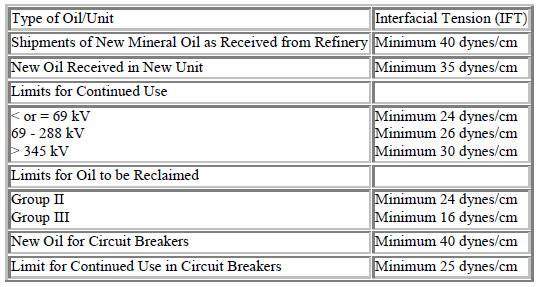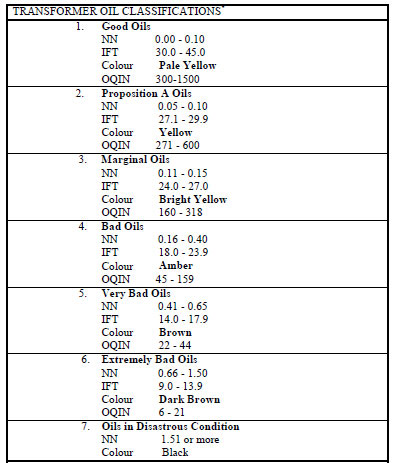By I.A.R. Gray
Transformer Chemistry Services
Background:
The interfacial tension of a mineral oil insulating fluid is related to the deterioration of the sample. The mineral oil insulating fluid is essentially a non-polar saturated hydrocarbon; however, when the sample undergoes oxidative degradation there are formed oxygenated species such as carboxylic acids, which are hydrophilic in nature. The presence of these hydrophilic materials in the insulating fluid can affect the chemical (acidity), electrical (dielectric strength), and physical (interfacial tension) properties of the fluid. In this procedure one measures the surface tension of the oil against that of water, which is highly polar. The more nearly the two liquids are alike in their polarity the lower the value of the surface tension between them. Thus the higher the concentration of hydrophilic materials in the insulating fluid, the lower will be the interfacial tension of the oil measured against water. There are several methods that can be used to measure the interfacial tension of an oil against water. One method measures the size of a drop of water that is formed below the surface of the oil (ASTM D2285); however, if one desires more accurate values it is recommended that the ring method described below be used.
Procedure:
The details of the entire procedure for determining the interfacial tension (IFT) of oil against water by the ring method are given in the ASTM D971 standard and are only briefly mentioned here. The device used to determine the IFT is a tensiometer based on the Du Nuoy principle. A sample of oil is carefully floated on top of a layer of water and the force necessary to pull a platinum ring upward from below the water level through the oil is measured by using a calibrated torsion wire. The force is measured at the point at which the ring breaks free of the water layer as it is being pulled upward through the oil layer. The platinum ring is made to precise dimensions. Since this test is very sensitive to trace contaminants, one must be very thorough in handling the sampling device, the sample, and the instrument. There are correction factors that have to be taken into consideration relating to the dimensions of the ring and the densities of the water and sample. The results are given in units of dynes/cm or the numerically equivalent units of milliNewtons/meter (mN/m).
Significance:
The magnitude of the IFT is inversely related to the concentration of the hydrophilic degradation products from the deterioration of the oil. Since the hydrophilic materials are usually highly polar and thus not very soluble in the non-polar oil, the presence of these species can result in sludge formation. These materials that remain dissolved in the oil can affect the desired electrical properties of the oil. They will reduce the dielectric strength and increase the dissipation factor of the oil. Sludge build-up can also affect the heat transfer characteristics of the oil by slowing or perhaps even blocking circulation of the oil. There is usually an inverse relationship between the neutralization number of an oil and its IFT. As an oil sample undergoes oxidative degradation, its neutralization number will increase while its IFT value will decrease. It should also be recognized that a decrease in the IFT does not imply that the acidity must also be high, since there are other non-acidic contaminants that could be present in the oil that are hydrophilic and will lower the IFT but not raise the acidity. An example of such a situation might be that of a free breathing transformer near salt water where a salt-water mist might be able to enter the unit. Such an event will not affect the acidity but would markedly affect the IFT and dielectric strength of the oil. The IEEE has suggested guidelines for IFT values depending on the type of oil and the unit it is being used in (IEEE C57.106-1991). Some representative values are given below:

QUALITY INDEX SYSTEM
Dividing the Interfacial Tension (IFT) by the Neutralisation Number (NN) provides a numerical value that is an excellent means of evaluating oil condition. This value is known as the Oil Quality Index (OQIN) or Myers Index Number (MIN). A new oil, for example has an OQIN of 1500.


The four functions of insulating oil are to provide cooling, insulation, protection against chemical attack and prevention of sludge build-up.
The first category is Good in which these functions are efficiently provided.
The second category Proposition A provides all the required function; a drop in IFT to 27.0 may signal the beginning of sludge in solution.
The insulating oil in the third category, Marginal Oils is not providing proper cooling and winding protection. Organic acids are beginning to coat winding insulation; sludge in insulation voids is highly probable.
The categories 4 to 6 Bad Oils, sludge have already been deposited in and on transformer parts in almost 100 percent of these units. Insulation damage and reduced cooling efficiency with higher operating temperatures characterize the Very Bad and Extremely Bad categories.
The last category "Disaster City" the concern should be how much life remains in the transformer, not just the oil condition.
Once the oil colour changes from the yellows into amber's and browns, the oil has degraded to the point where the insulation system has been affected Radical colour changes may be caused by: Electrical problem, Pot head or bushing compounds, uncured varnishes or polymers, new oil in a dirty unit.
The situation where NN and IFT were bad, but the colour was light may indicate contamination from sources other than oxidation i.e. a refining problem.



